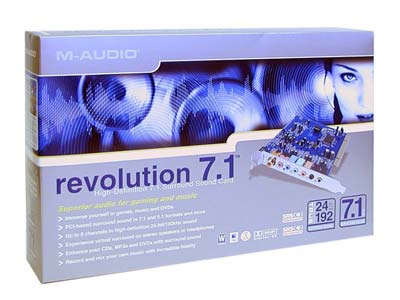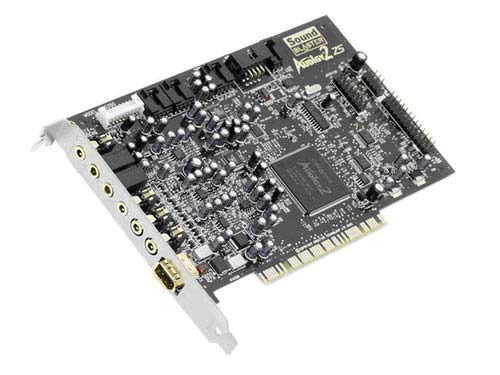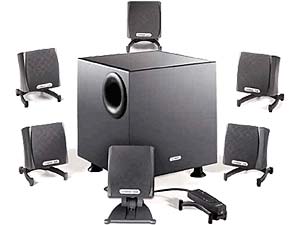High End Buyer's Guide - September 2004
by Wesley Fink on August 30, 2004 12:22 AM EST- Posted in
- Guides
Sound Card
Recommendation: M-Audio Revolution 7.1Price: $94
Some tastes run more to sound quality than gaming on the PC and we would recommend the M-Audio Revolution 7.1 for those buyers.

At about the same price as a retail Audigy 2 ZS, the M-Audio brings you the superb Envy 24HT chipset. This is the same family chipset that powers other well-regarded audio cards like the more expensive Terratec, and this is the full-blown 24/192 version. With a S/N ratio of more than 107db, and 24-bit/192kHz payback on all channels, the Revolution 7.1 is a card that will compare well to the best from anyone. The IO capabilities are also stellar, with both 7.1 speaker outputs and coaxial SPDIF. Even the microphone and analog inputs have a very respectable recording specification of 24-bit/96 kHz, and the Analog to Digital S/N, which most cards won't even quote, is a silent 100db.
If your audio goals are even more ambitious in a high end system, M-Audio specializes in cards to satisfy a home studio user. Recommended cards included the M-Audio Audiophile 24/96 with pro-grade A/D converters and a 4-in/4-out gold-plated IO cable for about $150, and the whole Delta line with expanded inputs and outputs up to 10 in and 10 out - and still under $300.
As we've said before, there are people who don't need this kind of audio processing power - even on a high-end system. For those users, we simply suggest that you use your motherboard's onboard sound controller. On-board audio solutions are becoming increasingly capable, with recent on-board chips capable of 7.1 audio and high-definition audio. Some people could care less about their system's sound as long as it supports their applications and there isn't any interference or crackling. If that description fits you to a tee, then use the onboard sound controller and forget about adding an audio card.
Alternative: Creative Labs Sound Blaster Audigy 2 ZS (7.1) retail
Price: $90
While the Sound Blaster Audigy 2 series may not be the best performing audio cards that you can buy, it is hard to argue with their universal compatibility as the standard for sound in computer gaming.

If you're a big gamer, then the top choice for a sound card is the Audigy 2. The Audigy 2 ZS is also a good card for those who love watching Dolby Digital DVD movies, or for someone who just wants decent quality sound. This version of the Audigy 2 supports 8 channels of sound and will deliver a great listening experience in any game, especially ones that support the Audigy 2's special features, like EAX. Simply pair the Audigy 2 with the right set of speakers and you'll have the necessary tools for an exceptional listening experience. Other special Audigy 2 features include 24/96 analog playback and recording, and "add-ons" like FireWire.
The Audigy 2 ZS differs from the regular OEM Audigy 2 mainly in its support of 7.1 channels of sound instead of 6.1. The benefit of going to 7.1 isn't really all that huge, as there's a point that you reach where continually adding more channels yields diminishing returns; that is, your surround sound experience doesn't get a whole lot better going from 6.1 to 7.1 channels, or for that matter, 5.1 to 7.1 channels, depending on how sensitive your ears are. The Audigy 2 ZS is also a retail package instead of OEM, meaning you get additional bundled features, such as video games and a FireWire header.
Speakers
Recommendation: Klipsch Pro Media Ultra 5.1 speakersPrice: $357 shipped

There will probably be some flak with recommending 5.1 speakers with a 7.1 audio card. If you are looking for 7.1 speakers, then neither of our recommended speakers or our alternative recommendation will provide that feature. However, our recommended audio cards will do a wonderful job in powering either of our recommended speaker systems. The Klipsch Pro Media Ultra 5.1 speakers are recommended for one simple reason - they sound better than any other speakers that we have listened to on a computer. When we find 7.1 speakers that sound just as good, they will get our recommendation.
Some computer components become almost legendary, and if you will check out any Forum discussions of speakers, you will find the Klipsch mentioned with reverence. Klipsch is a well-known audiophile speaker manufacturer, but that does not always translate into great performance with powered speakers. The Pro Media 5.1 system works very well, and typical Klipsch, they even quote honest Total Harmonic Distortion in their specifications. Those accustomed to reading specs from a typical set of Asian speakers will not be impressed with 25-20000 +/- 5db for frequency response, or THD specifications of "per Satellite: 60watts/ channel@=‹1% THD,100Hz - 1,000Hz; Subwoofer: 170watts@=‹3% THD, 40Hz - 100Hz". However, audio enthusiasts will likely find the honest ratings and superb sound a refreshing change from the usual hype that goes with computer speakers. The Klipsch also includes a remote control for the speaker system "power box".
Alternative: Creative Labs Megaworks THX Certified 6.1 speakers
Price: $248 shipped

This speaker system provides 6.1 output and is an excellent value at a delivered price of $248. The sound is quite outstanding, but not quite the equal of the more expensive Klipsch Pro Media in our opinion. If you do decide to buy the Creative Megaworks, however, you will not be disappointed, with features and specifications of:
- 6.1 surround sound
- 99 dB signal to noise ratio
- 150W subwoofer
- 70W per satellite and 75W for the center
- Positional audio support.
If you absolutely have to have 7.1 support, then the Creative Gigaworks 7.1 speakers at about $426 (delivered) is available. We haven't auditioned the Gigaworks yet, but it will have to provide something that we have not seen in other 7.1 systems in order to beat the pure performance of the Klipsch Pro Media, which even costs less. No one would believe that there are speakers more expensive than Klipsch, but in this case, there really are more expensive computer speaker systems.
If you cannot find the lowest prices on the products that we've recommended on this page, it's because we don't list some of them in our RealTime pricing engine. Until we do, we suggest that you do an independent search online at the various vendors' web sites. Just pick and choose where you want to buy your products by looking for a vendor located under the "Vendor" heading.










53 Comments
View All Comments
decptt - Sunday, September 12, 2004 - link
Sep 11, No OC guide again -_-"I am waiting for Fink' comment about HS/HSF.
rbils - Wednesday, September 8, 2004 - link
Ignore me. I read the comments last week, and didn't bother to read them again before I posted today. Sorry!rbils - Wednesday, September 8, 2004 - link
I didn't notice in the article, but are you using the included (retail) heatsink and fan that ships with the AMD processor? If so, do you feel that it is adequate as installed? I've read so much lately about 3rd party CPU coolers and thermal compound that it has me questioning whether or not the items shipping with the retail CPU are sufficient.Wesley Fink - Thursday, September 2, 2004 - link
The 480W True Power has been more than adequate for my tests, BUT the OCZ 520W was my recommendation for the last Overclocking Guide. I personally believe the Antec 480W is more than adequate, but the OCZ 520W does provide an extra margin of safety - particularly if you plan to overclock your video card or seriously overclock the whole system. The OCZ 520 has the added advantage of both 24-pin and 20 pin compatability as well. If you can handle the OCZ price of $150 it is an excellent choice.As for coolers, water cooling and phase-change are outstanding, but specialized and expensive, and beyond the scope of our recommendations. I have had good success with the stock A64 cooler made by Ajigo, and it is MUCH better than past AMD coolers - even for some modest overclocking. If you want more, there are coolers that do a better job. My favorites are the Scythe Samurai, the Thermalright SLK948U, and the Thermaltake Silent Boost K8. The Gigabyte 3D Cooler Ultra GT is also great-looking, but it really doesn't add that much in the way of improved cooling over the stock fan. The Samurai, SLK948U, and Gigabyte are Universal HSF and will work on most sockets.
southernpac - Thursday, September 2, 2004 - link
Congradulations on a comprehensive and well thought out guide. I will very shortly be relying on it a lot. Two concerns: As #16 has testified to his 480W PSU being inadequite, I would like for AnandTech to comment on this (we are relying on your advise in making this purchase). I realize that nVidia has revised their power requirement downward, but only after a lot of critism. As I don't want any more heat in the case than is really necessary, SHOULD more than 480W be shown necessary, I would also like your view of OCZ's 520W PSU.The one hole in the review certainly appears to be the lack of a recommendation for a better than "decent" (read adequite) cooler. If there are "better solutions" available - the high-end system should have it. Heat is the enemy of electronics, so the best cooler is worth while, particularly at only about $50. However it's not that simple - hence the need for a recommendation. #44 for example advocates his Zalman CNPS7000B-Cu, but if you look at Zalman's own site info on this cooler, Zalman specifically disavows moving any system having an installed cooler weigning over 450g. The 7000B-Cu weighs 755g (50% over Zalman's own limit). Many high-end coolers have similar weight. The just released Gigabyte 3D Rocket heat pipe cooler has just reduced it's weight to ONLY 500g's - but is it still effective now that it's aluminium instead of copper? Wesley please, we need a recommendation! In spite of the above - a great guide! Bill
NoGodForMe - Thursday, September 2, 2004 - link
Great article.I'd be interested in seeing if the Thermalright XP-120 fits in the Asus AV8 and other AMD boards for the FX53.
And most of these products are still hard to find. I'm sure someone will say they can get them, but it's very hard to do. For example, find me a BFG 6800 Ultra OC.
southernpac - Thursday, September 2, 2004 - link
gimper48 - Thursday, September 2, 2004 - link
When is the next Overclocking Review?!!swampy11 - Wednesday, September 1, 2004 - link
I certainly agree with your picks for the Hi-end set-up, but here is my question. With the new PCI-Express just around the corner and the supposed "horsepower" gain by this new architecture, should I jump in now with your suggested Hi-end recommendation or wait until the newer GPU and MB bear fruit.... probably fourth quarter?Thanks
`swamp
Uff - Wednesday, September 1, 2004 - link
Personally, I had quite a negative experience with my stock cooler, as soon as I locked the cam lever, it bent my motherboard just enough to make my RAM not make contact with the slots in the middle, resulting in failed boots. In addition to that, while it did keep my cpu temps at reasonable levels they were far from perfect.2 days later i received my Zalman 7000B-Cu and my temps dropped over 10C even if the cooler was running in silent mode (which is practically inaudible as opposed to the level of noise you get with the retail HSF).
While the stock cooler might do its job (barely), this was, after all, a high-end guide, and there's nothing high-end about that HSF.